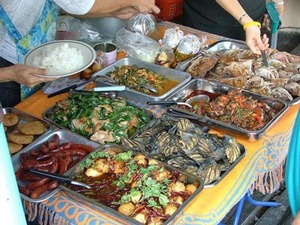I’ll admit it – I’m a complete sucker for Thai food and I can barely resist the urge to turn into the local Thai restaurant, every time I drive past. But while the food is always delicious, one can’t help but wonder how something so decadently yummy can actually be good for you. Are you one of those people that wonders if Thai food is healthy or do you suspect it’s fattening? You might be surprised to learn the truth!
“People in Thailand aren’t fat.”
I’ve often heard people use this arguement, pointing out that the majority of people in Thailand aren’t suffering from the obesity epidemic that plagues the United States, hence why Thai food simply MUST be good for you. But there are several things that we have to take into consideration before we can fairly compare the two.
Exercise: The majority of people in Thailand get a lot of exercise. The most common forms of transportation are either riding a bicycle or simply hoofing it from place to place, using one’s own feet. Because active individuals burn more calories, they keep the fat off better than someone who leads a sedetary lifestyle.
Portion: Americans are obsessed with portion size and often flock to restaurants that serve you the largest amount of food for the least amount of money. In Thailand, portion sizes are much smaller and more realistic of the amount of calories our bodies need for energy. What might seem like an appetizer in the U.S. can easily be a full meal in other countries.
Frequency: In Thailand, there are many different food and snack bars available. Snacking on smaller portions of healthy snacks such as fruit and nuts, more frequently throughout the day, is less fattening than gorging on a couple of big meals a day.
Restaurant Cooking Vs. Home Cooking
Have you ever noticed that the hamburger you buy at the fast food restaurant is better-tasting than the one you make at home? This is often because the fast food burgers are mass produced and injected with fats to make them more tasty. The same basic concept is true when you compare Thai restaurants with homemade Thai food. There are often different ways of preparing foods, which make them appeal more in a restaurant setting. For instance, Tom Yum is a very popular Thai hot soup that is served with either chicken or shrimp. A more modern alternative to this traditional soup, often served in restaurants, is served with a mixture of coconut milk and cream in it. Needless to say, this takes a normally healthy soup and turns it into a fattening (albeit delicious) decadence.
Traditional Thai dishes contain a lot of delicious vegetables, mainly because vegetables are less expensive than meat and other fillers. However, if you went into a restaurant and found your dinner was mostly vegetables, chances are that you might feel that you hadn’t gotten your money’s worth for your dinner. This is an important thing to keep in mind when going to Thai restaurants – while you may be eating Thai food, it may not be prepared the same way and portions may have been altered to suit Western tastes.
Some of the Unhealthiest Thai Dishes For Dieters To Avoid
If you’re really worrying about watching your waistline, be sure to avoid the following dishes:
Curries with coconut milk: I’m a sucker for delicious Thai curries, especially when they’re made with rich coconut milk. The spicy tang of the curry combined with the sweet coconut milk is a delight for the tastebuds but a sure way to pack on the pounds. Sadly, coconut milk is very high in saturated fat and even the reduced-fat version is considerably higher than reduced fat cow’s milk.
Moo Dad Diew: It looks delicious. It smells delicious and it tastes even better. Unfortunately, this tantalizing pork dish is fried twice, making it double the trouble. Add a side of starchy sticky rice and you’re looking at a definite artery-clogger.
Pad Thai: If you’re watching your carb intake, you may want to veer away from this one. Not only is it a fried dish, but you also have high-carb noodles and there’s quite a few calories in the sauce.
Satay: One of the most popular Thai dishes is Peanut Satay, but watch out for this yummy sauce. Not only does it contain peanuts (which many people are allergic to), but it also contains a lot of calories (which I try to claim I’m allergic to as well).
Pad Ga Pow Moo Kai Dow: This dish will really give your diet a “Pow!” if you aren’t careful. Stir fried in oil, the chicken or pork is then poured over a bed of sticky rice and served with fried egg on the side. The combination of fried food, the starchy rice and the high cholesterol from the fried egg makes this a definite no for anyone looking for a heart-smart meal.
So How Do You Dodge the Calories?
So how can you enjoy delicious Thai cuisine without expanding your girth? Easy! Instead of making regular trips out to the local Thai restaurants, try preparing some delicious Thai dishes at home – you’ll be surprised how easy some of them are to make. In addition to finding out how delicious and nutritious home-cooked Thai food is, you’ll also win some definite bonus points from the family or that special someone when you cook them an exotic Thai meal.
Sources:
Own experience, cooking Thai dishes
http://www.abc.net.au/health/thepulse/stories/2008/09/25/2372372.htm – Information about the fat content of coconut milk.





